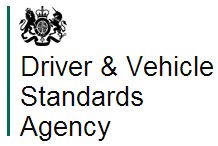Driver and Vehicle Standards Agency
 | |
| Abbreviation | DVSA |
|---|---|
| Formation | 1 April 2014 |
| Merger of | Driving Standards Agency Vehicle and Operator Services Agency |
| Type | Government agency (Trading fund) |
| Purpose | Helping you stay safe on Britain's roads |
| Headquarters | Berkeley House, Croydon Street, Bristol, BS5 0DA |
Region served | Great Britain |
Chief Executive | Gareth Llewellyn[1] |
Main organ | DVSA board |
Parent organization | Department for Transport |
| Affiliations | DVLA, MCA, VCA, Highways England |
Staff | 4,600 |
| Website |
www |
The Driver and Vehicle Standards Agency (DVSA) is an executive agency of the UK Department for Transport (DfT).
It carries out driving tests, approves people to be driving instructors and MOT testers, carries out tests to make sure lorries and buses are safe to drive, carries out roadside checks on drivers and vehicles, and monitors vehicle recalls.
The responsibilities of DVSA only cover Great Britain. In Northern Ireland the same role is carried out by the Driver and Vehicle Agency (DVA).
History
It was announced on 20 June 2013 that the Driving Standards Agency (DSA) and Vehicle and Operator Services Agency (VOSA) would merge into a single agency in 2014.[2] The name of the new agency was confirmed as the Driver and Vehicle Standards Agency (DVSA) on 28 November 2013.[3]
DSA and VOSA were abolished on 31 March 2014, and DVSA took over their responsibilities on 1 April 2014.
Purpose and aims
DVSA's stated purpose is "helping you stay safe on Britain's roads". It does this by:
- helping people through a lifetime of safe driving
- helping people keep their vehicles safe to drive
- protecting people from unsafe drivers and vehicles
On 30 March 2017, DVSA published a strategy for 2017 to 2022[4] setting out how it would do this.
Responsibilities
DVSA is responsible for:
- setting the standard for safe and responsible driving and riding
- carrying out theory and practical driving tests for all types of motor vehicles
- maintaining the register of approved driving instructors
- approving training bodies and instructors to provide compulsory basic training and direct access scheme courses for motorcyclists
- running the tests that allow people to join and stay on the voluntary register of driver trainers who train drivers of car and van fleets
- setting the standards for the drink-drive rehabilitation scheme, running the scheme and approving the courses that offenders can take
- conducting annual testing of lorries, buses and trailers through authorised testing facilities (ATFs) and goods vehicle testing stations (GVTS)
- conducting routine and targeted checks on vehicles, drivers and operators ensuring compliance with road safety legislation and environmental standards
- supervising the MOT scheme so that over 20,000 authorised garages carry out MOT tests to the correct standards
- providing administrative support to the Traffic Commissioners in considering and processing applications for licenses to operate lorries, buses, coaches and registered bus services
- conducting post-collision investigations
- monitoring products for manufacturing or design defects, highlighting safety concerns and monitoring safety recalls
- providing a range of educational and advisory activities to promote road safety
See also
References
- ↑ "Driver and Vehicle Standards Agency - Our management". GOV.UK. 9 April 2016. Retrieved 9 April 2016.
- ↑ "Improving services for motorists". GOV.UK. 20 June 2013. Retrieved 23 May 2017.
- ↑ "Driver and Vehicle Standards Agency named". GOV.UK. 28 November 2013. Retrieved 23 May 2017.
- ↑ "DVSA strategy, 2017 to 2022". GOV.UK. 30 March 2017. Retrieved 23 May 2017.